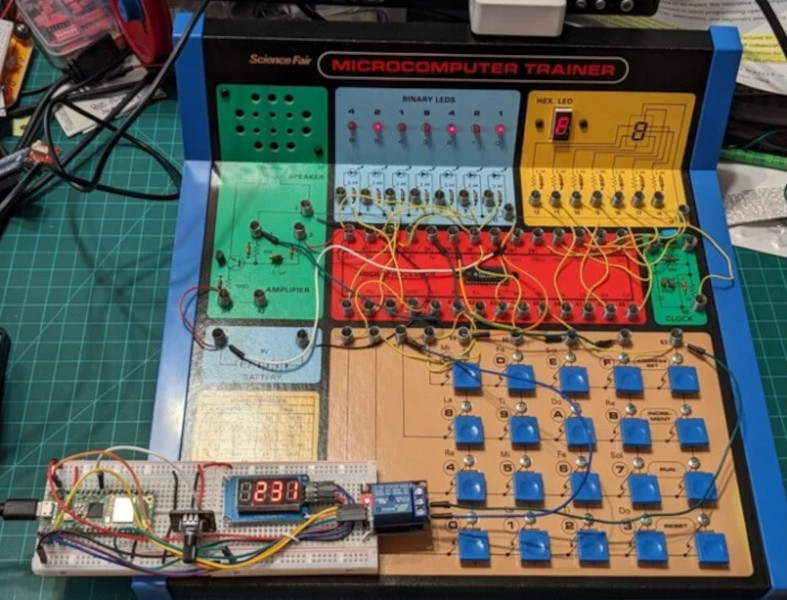While most of us now remember Radio Shack as a store that tried to force us to buy batteries and cell phones whenever we went to buy a few transistors and other circuit components, for a time it was an innovative and valuable store for electronics enthusiasts before it began its long demise. Among other electronics and radio parts and kits there were even a few DIY microcomputers, and even though it’s a bit of an antique now a Raspberry Pi Pico is just the thing to modernize this Radio Shack vintage microcomputer kit from the mid 80s.
The microcomputer kit itself is built around the 4-bit Texas Instruments TMS1100, one of the first mass-produced microcontrollers. The kit makes the processor’s functionality more readily available to the user, with a keypad and various switches for programming and a number of status LEDs to monitor its state. The Pi Pico comes into the equation programmed to act as a digital clock with an LED display to drive the antique computer. The Pi then sends a switching pulse through a relay to the microcomputer, which is programmed as a binary counter.
While the microcomputer isn’t going to win any speed or processing power anytime soon, especially with its clock signal coming from a slow relay module, the computer itself is still fulfilling its purpose as an educational tool despite being nearly four decades old. With the slow clock speeds it’s much more intuitive how the computer is stepping through its tasks, and the modern Pi Pico helps it with its tasks quite well. Relays on their own can be a substitute for the entire microcontroller as well, like this computer which has a satisfying mechanical noise when it’s running a program.
















Hmm, I am not sure I get it. The problem with the Science Fair trainer is that you cannot really extend it – it’s an entirely closed system, one chip, no external address or databus to which you could latch on for a real extension. This is basically pushing one of its buttons with a relay that is controlled by a Pico. I don’t think that counts as an enhancement or extension of the system. It’s merely a Pico-powered button pusher. Or am I missing something?
So, basically this proves that the Pico can push the INCR button faster than you can. Point taken.
Can it push it faster than a 555?
Can the circuit recognize those pulses though?
The 100in1 kits were better.
I recall making a spark gap generator to quite the awful music my sister liked (Da-Doo RunRun).
First useful circuit, built in middle school.
OK, not first. First non-explosive triggering circuit.
I have a project where I am putting this computer trainer’s parts into a Speak & Math case. One of the things that infuriated me as a teen about this kit was how the cheapo “Morse code” style keys would bounce when entering commands, and you’d skip an address and have to cycle through a bunch of stuff to fix the typo. I’ve added a mechanical switch keyboard and got keycaps that I can label in the style of the original there.
This chip and “microcomputer” of sorts showed up a few places in different forms. The most interesting one I’ve seen is the Gakken FX R-165.
I wanted to add some sort of debounce to the system, and the best I could come up with was to use good quality mechanical keys and hope that is enough, the way the processor does things electrically seems odd to me.
Off topic:
“most of us now remember Radio Shack as a store that tried to force us to buy batteries”
Myself, I remember Radio Shack as the place that refused to sell me batteries (for cash) unless I gave them my phone number. As it turned out, other places had batteries that they were willing to sell to me for just the price of the batteries.
lol; forced to buy batteries? “Battery of the Month Club” was a $5.88 value!
https://imgur.com/gqlE0Ou
Ah, Radio Shack. the free battery of the month club. I had a card, my bro had a card, my dad/mon had a card. We’d “do the rounds” of the local radio shacks, and get our free battery each.
It’s towards the very end of the program where I tried to use 4 at once “for my family members” where they announced it was causing too much grief and took my 4 cards. I happy handed over the 12 other cards I had since they were of no more use to me :)
My first PC was a Tandy 1000HX, 256kb ram, 720k floppy, and Tandy Graphics [ Think EGA+ ] , later upgraded with a 300 baud modem, and a whopping 640k [ 1MB ] of ram.
Those were the days!
Radio Shock, a Dandy Company ™ aka “Hz So Good”
For a much more impressive hack, and for anyone nostalgic for these, check out this emulator on tindie https://www.tindie.com/products/subsystems/4-bit-microcontroller-trainer-v20/
Yeah, while this one is clearly inspired by the Gakken FX R-165 (Radio Shack, Gakken GMC-4), it’s not compatible – the instruction set is slightly different. Similar emulators have been made before, for example, the Gakken GMC-4 is probably just an Arduino or the like. It was even re-released in 2013 in Germany: https://www.amazon.de/-/en/Burkhard-Kainka/dp/3645651608